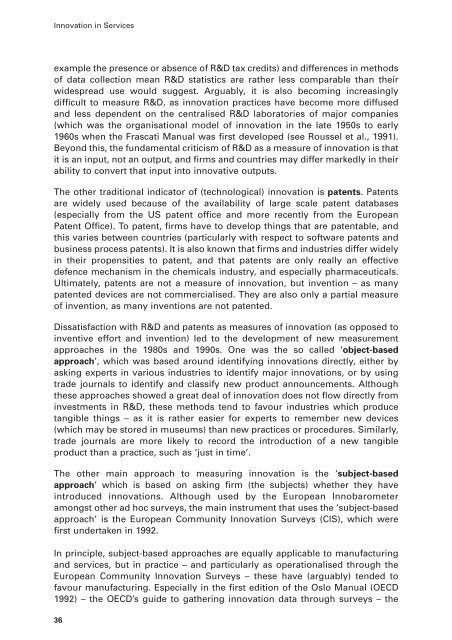Innovation in Services - Department for Business, Innovation and Skills
Innovation in Services - Department for Business, Innovation and Skills
Innovation in Services - Department for Business, Innovation and Skills
Create successful ePaper yourself
Turn your PDF publications into a flip-book with our unique Google optimized e-Paper software.
<strong>Innovation</strong> <strong>in</strong> <strong>Services</strong><br />
example the presence or absence of R&D tax credits) <strong>and</strong> differences <strong>in</strong> methods<br />
of data collection mean R&D statistics are rather less comparable than their<br />
widespread use would suggest. Arguably, it is also becom<strong>in</strong>g <strong>in</strong>creas<strong>in</strong>gly<br />
difficult to measure R&D, as <strong>in</strong>novation practices have become more diffused<br />
<strong>and</strong> less dependent on the centralised R&D laboratories of major companies<br />
(which was the organisational model of <strong>in</strong>novation <strong>in</strong> the late 1950s to early<br />
1960s when the Frascati Manual was first developed (see Roussel et al., 1991).<br />
Beyond this, the fundamental criticism of R&D as a measure of <strong>in</strong>novation is that<br />
it is an <strong>in</strong>put, not an output, <strong>and</strong> firms <strong>and</strong> countries may differ markedly <strong>in</strong> their<br />
ability to convert that <strong>in</strong>put <strong>in</strong>to <strong>in</strong>novative outputs.<br />
The other traditional <strong>in</strong>dicator of (technological) <strong>in</strong>novation is patents. Patents<br />
are widely used because of the availability of large scale patent databases<br />
(especially from the US patent office <strong>and</strong> more recently from the European<br />
Patent Office). To patent, firms have to develop th<strong>in</strong>gs that are patentable, <strong>and</strong><br />
this varies between countries (particularly with respect to software patents <strong>and</strong><br />
bus<strong>in</strong>ess process patents). It is also known that firms <strong>and</strong> <strong>in</strong>dustries differ widely<br />
<strong>in</strong> their propensities to patent, <strong>and</strong> that patents are only really an effective<br />
defence mechanism <strong>in</strong> the chemicals <strong>in</strong>dustry, <strong>and</strong> especially pharmaceuticals.<br />
Ultimately, patents are not a measure of <strong>in</strong>novation, but <strong>in</strong>vention – as many<br />
patented devices are not commercialised. They are also only a partial measure<br />
of <strong>in</strong>vention, as many <strong>in</strong>ventions are not patented.<br />
Dissatisfaction with R&D <strong>and</strong> patents as measures of <strong>in</strong>novation (as opposed to<br />
<strong>in</strong>ventive ef<strong>for</strong>t <strong>and</strong> <strong>in</strong>vention) led to the development of new measurement<br />
approaches <strong>in</strong> the 1980s <strong>and</strong> 1990s. One was the so called ‘object-based<br />
approach’, which was based around identify<strong>in</strong>g <strong>in</strong>novations directly, either by<br />
ask<strong>in</strong>g experts <strong>in</strong> various <strong>in</strong>dustries to identify major <strong>in</strong>novations, or by us<strong>in</strong>g<br />
trade journals to identify <strong>and</strong> classify new product announcements. Although<br />
these approaches showed a great deal of <strong>in</strong>novation does not flow directly from<br />
<strong>in</strong>vestments <strong>in</strong> R&D, these methods tend to favour <strong>in</strong>dustries which produce<br />
tangible th<strong>in</strong>gs – as it is rather easier <strong>for</strong> experts to remember new devices<br />
(which may be stored <strong>in</strong> museums) than new practices or procedures. Similarly,<br />
trade journals are more likely to record the <strong>in</strong>troduction of a new tangible<br />
product than a practice, such as ‘just <strong>in</strong> time’.<br />
The other ma<strong>in</strong> approach to measur<strong>in</strong>g <strong>in</strong>novation is the ‘subject-based<br />
approach’ which is based on ask<strong>in</strong>g firm (the subjects) whether they have<br />
<strong>in</strong>troduced <strong>in</strong>novations. Although used by the European Innobarometer<br />
amongst other ad hoc surveys, the ma<strong>in</strong> <strong>in</strong>strument that uses the ‘subject-based<br />
approach’ is the European Community <strong>Innovation</strong> Surveys (CIS), which were<br />
first undertaken <strong>in</strong> 1992.<br />
In pr<strong>in</strong>ciple, subject-based approaches are equally applicable to manufactur<strong>in</strong>g<br />
<strong>and</strong> services, but <strong>in</strong> practice – <strong>and</strong> particularly as operationalised through the<br />
European Community <strong>Innovation</strong> Surveys – these have (arguably) tended to<br />
favour manufactur<strong>in</strong>g. Especially <strong>in</strong> the first edition of the Oslo Manual (OECD<br />
1992) – the OECD’s guide to gather<strong>in</strong>g <strong>in</strong>novation data through surveys – the<br />
36
















